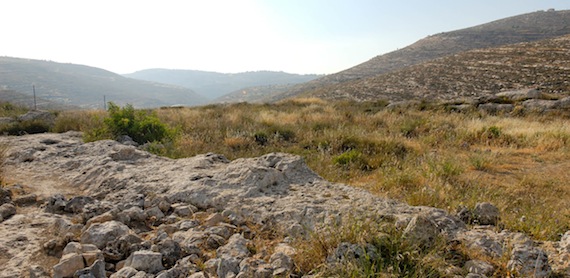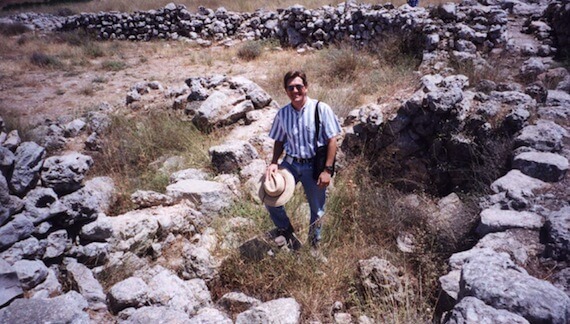Local schoolchildren ate their lunches across the olive grove from my wife and me.
Like the kids, we came on a field trip to explore ancient Shiloh. Although our lunch was hardly a feast, it reminded me of the reasons the young nation of Israel initially came to this site. They came to worship at the annual feasts before the Tabernacle at Shiloh.

(Photo: Area of the Tabernacle at Shiloh. Courtesy of Pictorial Library of Bible Lands)
Ask most Americans where Shiloh is, and you’ll likely get a blank stare.
- Historians may point to a Civil War battle in Hardin County, Tennessee.
- Music buffs may start singing the chorus to a Neil Diamond song.
But question someone who knows his or her Bible, and Shiloh means something far more significant.
Shiloh in the Bible: a Promise & a Person
The patriarch Jacob first spoke of Shiloh on his deathbed, giving a promise to the tribe of Judah:
The scepter shall not depart from Judah, nor the ruler’s staff from between his feet, until Shiloh comes, and to him shall be the obedience of the peoples. —Genesis 49:10
Most commentators agree that Jacob’s prediction had messianic overtones and included a promise of kings as well as a place of rest. Ultimately, the tribe of Judah would produce the Messiah, Jesus (Hebrews 7:14; Revelation 5:5).
After Israel entered the Promised Land, the Tabernacle of Moses indeed did rest from its wanderings. It rested at a place named Shiloh (Joshua 18:1).
Shiloh is a Place
After finishing lunch, I followed a path to where archaeologists have identified a large, level area. The space measures 400 feet long and 77 feet wide. Although not all agree, this place likely represents the place where the Tabernacle at Shiloh rested.
Examining the ruins, I saw an outline of the Tabernacle’s footprint. I walked to the back where the rocks roughly formed a rectangle.

(Photo: Standing where the Holy of Holies was.)
It was hard to take in the truth of it, but if the Tabernacle at Shiloh stood where I was standing, then the Holy of Holies had been beneath my feet. God’s glory — right there!
- For three centuries, those obedient among the tribes of Israel would have come here to the Tabernacle at Shiloh for the annual feasts.
- Joshua divided the tribes’ allotment of land at Shiloh (Joshua 18).
- At Shiloh, the godly woman, Hannah, prayed to conceive, and her son Samuel ministered before the Lord here (1 Samuel 1:1-28; 3:21).
- From the time Israel entered the land until the time of Samuel, the Ark of the Covenant remained in the Tabernacle at Shiloh.
Why did God destroy Shiloh? Because ancient Israel refused to walk with God,
He abandoned the dwelling place at Shiloh, the tent which He had pitched among men, and gave up His strength to captivity and His glory into the hand of the adversary. —Psalm 78:60-61
The Philistines took the Ark and destroyed Shiloh in 1104 BC (1 Samuel 4:10-11).
Shiloh is a Parable
Centuries later in the days of Jeremiah, the stubborn leaders of Judah had a false sense of security because they had the Temple of God in Jerusalem. So the Lord told Jeremiah to use Shiloh as a parable—or illustration.
Go now to My place which was in Shiloh . . . and see what I did to it. — Jeremiah 7:12
- Jeremiah’s words became prophetic, for twenty years later the Babylonians would destroy Solomon’s temple.
- After Herod rebuilt the temple, Jesus used Jeremiah’s words to predict what would happen if God’s people refused to listen to God’s messenger (Mark 11:15-17; Luke 21:6). Amazingly, the Second Temple was also destroyed in AD 70.
Once Israel came to the Tabernacle at Shiloh to worship at the feasts, but today only archaeologists, a few tourists, and schoolchildren visit.
Once the presence of God dwelt at Shiloh, but now only weeds and rocks remain.
Devotional Thought for Tel Shiloh
Read Jeremiah 7:1-15; 26:6; Mark 11:15-17.
“Go to Shiloh and see,” God said. In traveling to Shiloh, God’s people could see what happened when a previous generation did not follow Him.
The people of Jeremiah’s day, as well as those at the time of Jesus, felt that the presence of God’s temple gave them security.
- Both Jeremiah and Jesus pointed to Shiloh to show that security comes not from the Tabernacle at Shiloh or the Temple in Jerusalem.
- Security comes from God’s presence. For three hundred years, only the high priest could stand in the place of the Holy of Holies. But today, anyone can wander where the Tabernacle at Shiloh stood, because “the glory has departed” (1 Samuel 4:22).
Although today God’s temple is His church (1 Corinthians 3:16; 6:19) — and although He will never remove His Spirit from us (2 Corinthians 1:22; Ephesians 1:13; 4:30) — we do face the possibility that God may choose not to use us any longer (Revelation 2:5).
Let us remain faithful to the Lord so that we may remain a vessel through which His glory can shine to a watching world.
Tell me what you think: Where do you see people placing their security, even as Christians? To leave a comment, just click here.
Shiloh on the map:
Want to Explore Shiloh and Other Biblical Places?
Take a virtual journey through the Bible Lands. With Walking the Bible Lands, get to visit places you’ve read about in the Bible. Experience the Bible in a new way and deepen your relationship with God.

